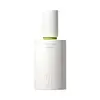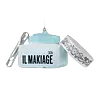What's inside
What's inside
 Key Ingredients
Key Ingredients

 Benefits
Benefits

 Concerns
Concerns

 Ingredients Side-by-side
Ingredients Side-by-side

Water
Skin ConditioningCitrus Limon Fruit Extract
MaskingDipropylene Glycol
HumectantTrehalose
HumectantSaccharomyces Ferment Lysate Filtrate
Skin ConditioningPolymethylsilsesquioxane
Vinyl Dimethicone/Methicone Silsesquioxane Crosspolymer
Glycereth-26
HumectantLactobacillus Ferment
Skin ConditioningAmmonium Acryloyldimethyltaurate/Vp Copolymer
Propanediol
Solvent1,2-Hexanediol
Skin ConditioningHydroxyacetophenone
AntioxidantButylene Glycol
HumectantSalvia Officinalis Extract
AntimicrobialAcrylates/Vinyl Isodecanoate Crosspolymer
Emulsion StabilisingTromethamine
BufferingCaprylyl Glycol
EmollientTremella Fuciformis Polysaccharide
Emulsion StabilisingAdenosine
Skin ConditioningEthylhexylglycerin
Skin ConditioningCaprylhydroxamic Acid
Pogostemon Cablin Leaf Extract
PerfumingScutellaria Baicalensis Root Extract
AstringentSophora Angustifolia Root Extract
Skin ConditioningTaraxacum Officinale Rhizome/Root Extract
Skin ConditioningHouttuynia Cordata Extract
Skin ConditioningGalactomyces Ferment Filtrate
HumectantLactobacillus/Soymilk Ferment Filtrate
Skin ConditioningPentylene Glycol
Skin ConditioningSoluble Collagen Crosspolymer
EmollientDisodium EDTA
Chondrus Crispus Extract
Skin ConditioningArginine
MaskingGlyceryl Caprylate
EmollientSodium Chloride
MaskingOligopeptide-1
Skin ConditioningFibronectin
Skin ConditioningWater, Citrus Limon Fruit Extract, Dipropylene Glycol, Trehalose, Saccharomyces Ferment Lysate Filtrate, Polymethylsilsesquioxane, Vinyl Dimethicone/Methicone Silsesquioxane Crosspolymer, Glycereth-26, Lactobacillus Ferment, Ammonium Acryloyldimethyltaurate/Vp Copolymer, Propanediol, 1,2-Hexanediol, Hydroxyacetophenone, Butylene Glycol, Salvia Officinalis Extract, Acrylates/Vinyl Isodecanoate Crosspolymer, Tromethamine, Caprylyl Glycol, Tremella Fuciformis Polysaccharide, Adenosine, Ethylhexylglycerin, Caprylhydroxamic Acid, Pogostemon Cablin Leaf Extract, Scutellaria Baicalensis Root Extract, Sophora Angustifolia Root Extract, Taraxacum Officinale Rhizome/Root Extract, Houttuynia Cordata Extract, Galactomyces Ferment Filtrate, Lactobacillus/Soymilk Ferment Filtrate, Pentylene Glycol, Soluble Collagen Crosspolymer, Disodium EDTA, Chondrus Crispus Extract, Arginine, Glyceryl Caprylate, Sodium Chloride, Oligopeptide-1, Fibronectin
Water
Skin ConditioningGlycerin
HumectantDimethicone
EmollientCyclopentasiloxane
EmollientPropanediol
SolventVinyl Dimethicone/Methicone Silsesquioxane Crosspolymer
Polymethylsilsesquioxane
Dimethicone Crosspolymer
Emulsion StabilisingPEG-9 Polydimethylsiloxyethyl Dimethicone
EmulsifyingSodium Chloride
MaskingXylitylglucoside
HumectantHydroxyacetophenone
AntioxidantAnhydroxylitol
HumectantCaprylyl Glycol
EmollientXylitol
HumectantParfum
MaskingAdenosine
Skin ConditioningGlucose
HumectantDisodium EDTA
1,2-Hexanediol
Skin ConditioningSoluble Collagen
HumectantMagnesium Aluminum Silicate
AbsorbentCI 42090
Cosmetic ColorantPhaseolus Radiatus Seed Extract
Skin ConditioningCaprylic/Capric Triglyceride
MaskingHydrogenated Lecithin
EmulsifyingRetinol
Skin ConditioningPolyglyceryl-10 Myristate
Skin ConditioningTocopheryl Acetate
AntioxidantLinalool
PerfumingWater, Glycerin, Dimethicone, Cyclopentasiloxane, Propanediol, Vinyl Dimethicone/Methicone Silsesquioxane Crosspolymer, Polymethylsilsesquioxane, Dimethicone Crosspolymer, PEG-9 Polydimethylsiloxyethyl Dimethicone, Sodium Chloride, Xylitylglucoside, Hydroxyacetophenone, Anhydroxylitol, Caprylyl Glycol, Xylitol, Parfum, Adenosine, Glucose, Disodium EDTA, 1,2-Hexanediol, Soluble Collagen, Magnesium Aluminum Silicate, CI 42090, Phaseolus Radiatus Seed Extract, Caprylic/Capric Triglyceride, Hydrogenated Lecithin, Retinol, Polyglyceryl-10 Myristate, Tocopheryl Acetate, Linalool
Ingredients Explained
These ingredients are found in both products.
Ingredients higher up in an ingredient list are typically present in a larger amount.
1,2-Hexanediol is a synthetic liquid and another multi-functional powerhouse.
It is a:
- Humectant, drawing moisture into the skin
- Emollient, helping to soften skin
- Solvent, dispersing and stabilizing formulas
- Preservative booster, enhancing the antimicrobial activity of other preservatives
Adenosine is in every living organism. It is one of four components in nucleic acids that helps store our DNA.
Adenosine has many benefits when used. These benefits include hydrating the skin, smoothing skin, and reducing wrinkles. Once applied, adenosine increases collagen production. It also helps with improving firmness and tissue repair.
Studies have found adenosine may also help with wound healing.
In skincare products, Adenosine is usually derived from yeast.
Learn more about AdenosineCaprylyl Glycol is a humectant and emollient, meaning it attracts and preserves moisture.
It is a common ingredient in many products, especially those designed to hydrate skin. The primary benefits are retaining moisture, skin softening, and promoting a healthy skin barrier.
Though Caprylyl Glycol is an alcohol derived from fatty acids, it is not the kind that can dry out skin.
This ingredient is also used as a preservative to extend the life of products. It has slight antimicrobial properties.
Learn more about Caprylyl GlycolDisodium EDTA plays a role in making products more stable by aiding other preservatives.
It is a chelating agent, meaning it neutralizes metal ions that may be found in a product.
Disodium EDTA is a salt of edetic acid and is found to be safe in cosmetic ingredients.
Learn more about Disodium EDTAHydroxyacetophenone is antioxidant with skin conditioning and soothing properties. It also boosts the efficiency of preservatives.
This ingredient is not irritating or sensitizing.
Polymethylsilsesquioxane is a silicone used as a film forming agent.
When applied to the skin, this ingredient creates an invisible film on the surface. This film still allows oxygen to pass through, but prevents moisture from escaping. This can help condition and hydrate the skin. It also leaves a silky feel when applied.
Polymethylsilsesquioxane has not been shown to clog pores. It has been deemed safe to use up to 55%, but most cosmetics use much less.
If you have concerns about using this ingredient, we recommend speaking with a professional.
Learn more about PolymethylsilsesquioxanePropanediol is an all-star ingredient. It softens, hydrates, and smooths the skin.
It’s often used to:
Propanediol is not likely to cause sensitivity and considered safe to use. It is derived from corn or petroleum with a clear color and no scent.
Learn more about PropanediolChances are, you eat sodium chloride every day. Sodium Chloride is also known as table salt.
This ingredient has many purposes in skincare: thickener, emulsifier, and exfoliator.
You'll most likely find this ingredient in cleansers where it is used to create a gel-like texture. As an emulsifier, it also prevents ingredients from separating.
There is much debate on whether this ingredient is comedogenic. The short answer - comedogenic ratings don't tell the whole story. Learn more about comegodenic ratings here.
The concensus about this ingredient causing acne seems to be divided. Research is needed to understand if this ingredient does cause acne.
Scrubs may use salt as the primary exfoliating ingredient.
Learn more about Sodium ChlorideThis ingredient is used in makeup and skincare to thicken formulas, reduce shine, and give skin a silky-smooth feel.
It’s a white silicone powder that sits in fine lines and pores to blur their appearance though its effectiveness depends on the particle size.
You'll typically find this ingredient in amounts between 0.1-20%.
Learn more about Vinyl Dimethicone/Methicone Silsesquioxane CrosspolymerWater. It's the most common cosmetic ingredient of all. You'll usually see it at the top of ingredient lists, meaning that it makes up the largest part of the product.
So why is it so popular? Water most often acts as a solvent - this means that it helps dissolve other ingredients into the formulation.
You'll also recognize water as that liquid we all need to stay alive. If you see this, drink a glass of water. Stay hydrated!
Learn more about Water